gearbox PORSCHE 911 CARRERA 2011 6.G Information Manual
[x] Cancel search | Manufacturer: PORSCHE, Model Year: 2011, Model line: 911 CARRERA, Model: PORSCHE 911 CARRERA 2011 6.GPages: 63, PDF Size: 9.45 MB
Page 9 of 63
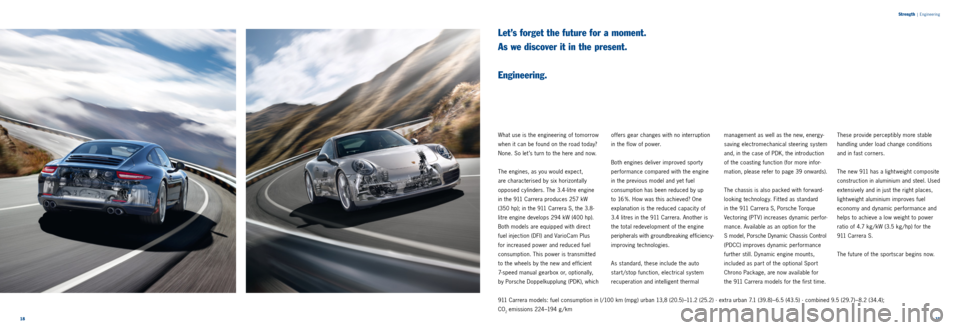
1819
Strength
|
Engineering
Let’s forget the future for a moment.
As we discover it in the present.
Engineering.
What use is the engineering of tomorrow
when it can be found on the road today?
None. So let ’s turn to the here and now.
The engines, as you would expect,
are characterised by six horizontally
opposed cylinders. The 3.4-litre engine
in the 911 Carrera produces 257 kW
(350 hp); in the 911 Carrera S, the 3.8-
litre engine develops 294 kW (400 hp).
Both models are equipped with direct
fuel injection (DFI) and VarioCam Plus
for increased power and reduced fuel
consumption. This power is transmit ted
to the wheels by the new and efficient
7-speed manual gearbox or, optionally,
by Porsche Doppelkupplung (PDK), which offers gear changes with no interruption
in the flow of power.
Both engines deliver improved sport y
performance compared with the engine
in the previous model and yet fuel
consumption has been reduced by up
to 16 %. How was this achieved? One
explanation is the reduced capacit y of
3.4 litres in the 911 Carrera. Another is
the total redevelopment of the engine
peripherals with groundbreaking efficiency-
improving technologies.
As standard, these include the auto
start/stop function, electrical system
recuperation and intelligent thermal management as well as the new, energy-
saving electromechanical steering system
and, in the case of PDK, the introduction
of the coasting function (for more infor
-
mation, please refer to page 39 onwards).
The chassis is also packed with forward-
looking technology. Fit ted as standard
in the 911 Carrera S, Porsche Torque
Vectoring (PT V) increases dynamic perfor -
mance. Available as an option for the
S model, Porsche Dynamic Chassis Control
(PDCC) improves dynamic performance
further still. Dynamic engine mounts,
included as part of the optional Sport
Chrono Package, are now available for
the 911 Carrera models for the first time. These provide perceptibly more stable
handling under load change conditions
and in fast corners.
The new 911 has a light weight composite
construction in aluminium and steel. Used
extensively and in just the right places,
lightweight aluminium improves fuel
economy and dynamic performance and
helps to achieve a low weight to power
ratio of 4.7 kg / kW (3.5 kg / hp) for the
9 11 C a r r e r a S .
The future of the sportscar begins now.
911 Carrera models: fuel consumption in l/100 km (mpg) urban 13,8 (20.5) –11.2 (25.2) · extra urban 7.1 (39.8) – 6.5 (43.5) · combined 9.5 (29.7) –8.2 (34.4);
CO
2 emissions 224–194 g / km
Page 10 of 63
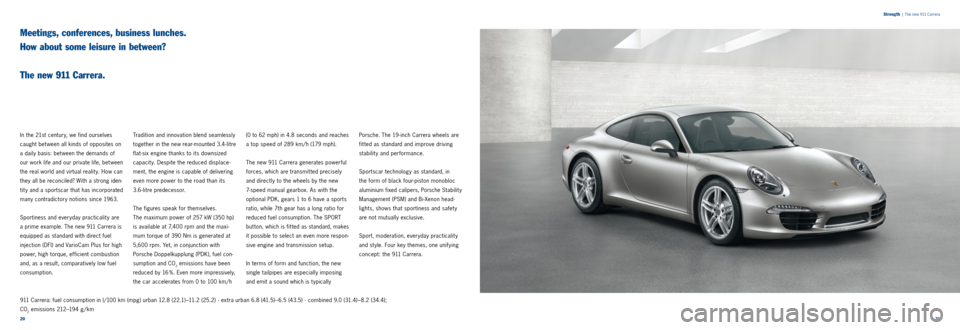
2021
Strength
| The new 911 Carrera
Meetings, conferences, business lunches.
How about some leisure in between?
The new 911 Carrera.
In the 21st century, we find ourselves
caught bet ween all kinds of opposites on
a daily basis: bet ween the demands of
our work life and our private life, between
the real world and virtual realit y. How can
they all be reconciled? With a strong iden -
tit y and a sportscar that has incorporated
many contradictory notions since 1963.
Sportiness and everyday practicality are
a prime example. The new 911 Carrera is
equipped as standard with direct fuel
injection (DFI) and VarioCam Plus for high
power, high torque, ef ficient combustion
and, as a result, comparatively low fuel
consumption. Tradition and innovation blend seamlessly
together in the new rear-mounted 3.4-litre
flat-six engine thanks to its downsized
capacity. Despite the reduced displace
-
ment, the engine is capable of delivering
even more power to the road than its
3.6-litre predecessor.
The figures speak for themselves.
The maximum power of 257 kW (350 hp)
is available at 7,400 rpm and the maxi -
mum torque of 390 Nm is generated at
5,600 rpm. Yet, in conjunction with
Porsche Doppelkupplung (PDK), fuel con -
sumption and CO
2 emissions have been
reduced by 16 %. Even more im pres
sively,
the car accelerates from 0 to 100 km/ h
(0 to 62 mph) in 4.8 seconds and reaches
a top speed of 289 km/ h (179 mph).
The new 911 Carrera generates powerful
forces, which are transmit ted precisely
and directly to the wheels by the new
7-speed manual gearbox. As with the
optional PDK, gears 1 to 6 have a sports
ratio, while 7th gear has a long ratio for
reduced fuel consumption. The SPORT
but ton, which is fit ted as standard, makes
it possible to select an even more respon -
sive engine and transmission setup.
In terms of form and function, the new
single tailpipes are especially imposing
and emit a sound which is t ypically Porsche. The 19-inch Carrera wheels are
fit ted as standard and improve driving
stability and performance.
Sportscar technology as standard, in
the form of black four-piston monobloc
aluminium fixed calipers, Porsche Stability
Management (PSM) and Bi-Xenon head -
lights, shows that sportiness and safety
are not mutually exclusive.
Sport, moderation, everyday practicality
and st yle. Four key themes, one unifying
concept: the 911 Carrera.
911 Carrera: fuel consumption in l/100 km (mpg) urban 12.8 (22.1) –11.2 (25.2) · extra urban 6.8 (41.5) – 6.5 (43.5) · combined 9.0 (31.4) –8.2 (34.4);
CO
2 emissions 212–194 g / km
Page 11 of 63
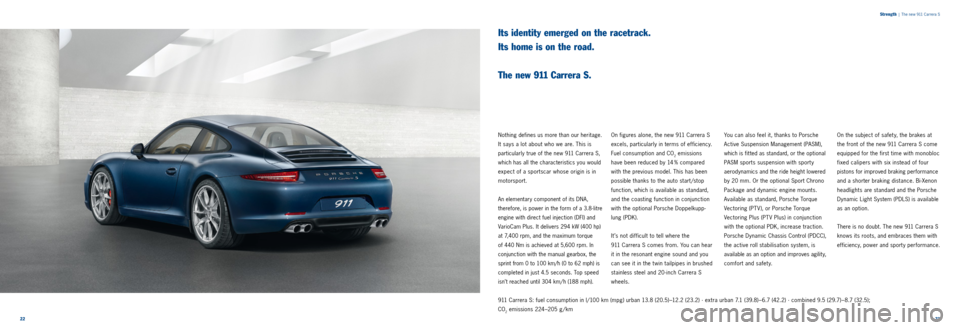
2223
Strength
| The new 911 Carrera S
Its identity emerged on the racetrack.
Its home is on the road.
The new 911 Carrera S.
Nothing defines us more than our heritage.
It says a lot about who we are. This is
particularly true of the new 911 Carrera S,
which has all the characteristics you would
expect of a sportscar whose origin is in
motorsport.
An elementary component of its DNA,
therefore, is power in the form of a 3.8-litre
engine with direct fuel injection (DFI) and
VarioCam Plus. It delivers 294 kW (400 hp)
at 7,400 rpm, and the maximum torque
of 440 Nm is achieved at 5,600 rpm. In
conjunction with the manual gearbox, the
sprint from 0 to 100 km/h (0 to 62 mph) is
completed in just 4.5 seconds. Top speed
isn’t reached until 304 km/ h (188 mph).
On figures alone, the new 911 Carrera S
excels, particularly in terms of efficiency.
Fuel consumption and CO
2 em issio ns
have been reduced by 14 % compared
with the previous model. This has been
possible thanks to the auto start /stop
function, which is available as standard,
and the coasting function in conjunction
with the optional Porsche Doppelkupp -
lung (PDK).
It ’s not difficult to tell where the
911 Carrera S comes from. You can hear
it in the resonant engine sound and you
can see it in the t win tailpipes in brushed
stainless steel and 20 - inch Carrera S
wheels. You can also feel it, thanks to Porsche
Active Suspension Management (PASM),
which is fit ted as standard, or the optional
PASM sports suspension with sport y
aerodynamics and the ride height lowered
by 20 mm. Or the optional Sport Chrono
Package and dynamic engine mounts.
Available as standard, Porsche Torque
Vectoring (PTV), or Porsche Torque
Vectoring Plus (PTV Plus) in conjunction
with the optional PDK, increase traction.
Porsche Dynamic Chassis Control (PDCC),
the active roll stabilisation system, is
available as an option and improves agility,
comfort and safet y. On the subject of safet y, the brakes at
the front of the new 911 Carrera S come
equipped for the first time with monobloc
fixed calipers with six instead of four
pistons for improved braking performance
and a shorter braking distance. Bi-Xenon
headlights are standard and the Porsche
Dynamic Light System (PDLS) is available
as an option.
There is no doubt. The new 911 Carrera S
knows its roots, and embraces them with
efficiency, power and sporty performance.
911 Carrera S: fuel consumption in l/100 km (mpg) urban 13.8 (20.5) –12.2 (23.2) · extra urban 7.1 (39.8) – 6.7 (42.2) · combined 9.5 (29.7) –8.7 (32.5);
CO
2 emissions 224–205 g / km
Page 13 of 63

2627
Temperament
|
Engines
To give more and take less.
That’s Porsche engineering.
Engines.
You could ask whether the sportscar is
still relevant. It would be a good question,
but you might as well ask the same of
dreams.
The answer to both questions lies in
the future or, to be more precise, in the
future of the sportscar. In the new 911,
the future has already begun. The highly
ef ficient, state - of-the -art engines make
a considerable contribution to reducing
fuel consumption, but their sound is still
unmistakably Porsche. The new 911 engines are also unmistaka
-
bly sport y thanks to the new SPORT
but ton fit ted as standard. At the push
of a button, the engine becomes tuned
for a sharper response and engine
dynamics that are even more direct.
The 3.4-litre engine of the new
911 Carrera demonstrates, therefore,
that performance and efficiency need
not be mutually exclusive. Rather, the
downsized engine capacity and increased
maximum torque are the intelligent basis
by which power output can be increased
in an environmentally acceptable and
sustainable way. Fuel consumption and CO2 emissions have been reduced
by up to 16 % compared with the previous
model.
In their search for improved efficiency,
our engineers analysed an extensive
series of engine components. Answers
were found, including rapid heating
of the engine and gearbox by the new
thermal management after an engine
start, optimised air induction and the
extremely effective direct fuel injection
(DFI).
The same principle applies to the 3.8-litre
engine in the 911 Carrera S. There has been no change in displacement since
the previous model, but power output has
been increased while fuel consumption
has been reduced by up to 14 %.
Weight is critical to efficiency. This is
why the engines have a light-alloy
construction, which makes them light -
weight and structurally rigid for improved
fuel economy and a long life.
The engine is the intelligent core of our
identit y. What else could the ‘Dr. Ing.’ in
our company name possibly stand for?
911 Carrera models: fuel consumption in l/100 km (mpg) urban 13,8 (20.5) –11.2 (25.2) · extra urban 7.1 (39.8) – 6.5 (43.5) · combined 9.5 (29.7) –8.2 (34.4);
CO
2 emissions 224–194 g / km
Page 14 of 63
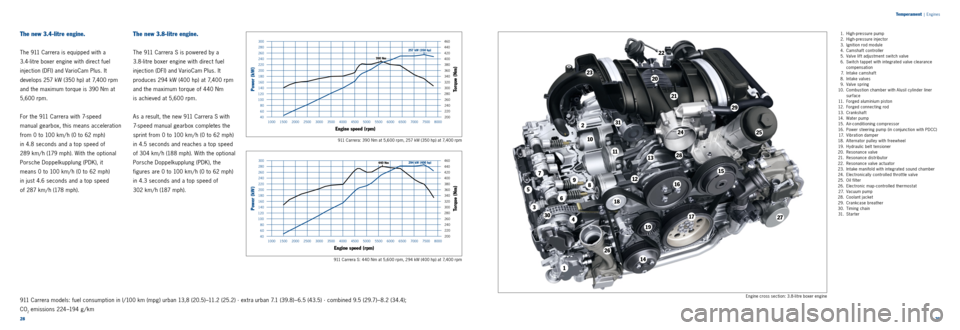
1
2
3
4
5
6
7
89
10
11
12
13
14
15
16
17
18
19
20
21
22
23
2425
26
27
28
29
30
31
2829
Temperament
|
Engines
Engine cross section: 3.8-litre boxer engine
911 Carrera S: 440 Nm at 5,600 rpm, 294 kW (400 hp) at 7,400 rpm
1. High - pressure pump
2. High-pressure injector
3. Ignition rod module
4. Camshaft controller
5. Valve lif t adjustment switch valve
6. Switch tappet with integrated valve clearance
compensation
7. Intake camshaf t
8. Intake valves
9. Valve spring
10. Combustion chamber with Alusil cylinder liner
surface
11. Forged aluminium piston
12. Forged connecting rod
13. Crankshaft
14. Water pump
15. Air-conditioning compressor
16. Power steering pump (in conjunction with PDCC)
17. Vibration damper
18. Alternator pulley with freewheel
19. Hydraulic belt tensioner
20. Resonance valve
21. Resonance distributor
22. Resonance valve actuator
23. Intake manifold with integrated sound chamber
24. Electronically controlled throttle valve
25. Oil filter
26. Electronic map-controlled thermostat
27. Vacuum pump
28. Coolant jacket
29. Crankcase breather
30. Timing chain
31. S t a r t e r
911 Carrera: 390 Nm at 5,600 rpm, 257 kW (350 hp) at 7,400 rpm
The new 3.4-litre engine.
The 911 Carrera is equipped with a
3.4-litre boxer engine with direct fuel
injection (DFI) and VarioCam Plus. It
develops 257 kW (350 hp) at 7,400 rpm
and the maximum torque is 390 Nm at
5,600 rpm.
For the 911 Carrera with 7-speed
manual gearbox, this means acceleration
from 0 to 100 km/ h (0 to 62 mph)
in 4.8 seconds and a top speed of
289 km/ h (179 mph). With the optional
Porsche Doppelkupplung (PDK), it
means 0 to 100 km/ h (0 to 62 mph)
in just 4.6 seconds and a top speed
of 287 km/ h (178 mph).
The new 3.8-litre engine.
The 911 Carrera S is powered by a
3.8-litre boxer engine with direct fuel
injection (DFI) and VarioCam Plus. It
produces 294 kW (400 hp) at 7,400 rpm
and the maximum torque of 440 Nm
is achieved at 5,600 rpm.
As a result, the new 911 Carrera S with
7-speed manual gearbox completes the
sprint from 0 to 100 km/ h (0 to 62 mph)
in 4.5 seconds and reaches a top speed
of 304 km/ h (188 mph). With the optional
Porsche Doppelkupplung (PDK), the
figures are 0 to 100 km/ h (0 to 62 mph)
in 4.3 seconds and a top speed of
302 km/ h (187 mph).
911 Carrera models: fuel consumption in l/100 km (mpg) urban 13,8 (20.5) –11.2 (25.2) · extra urban 7.1 (39.8) – 6.5 (43.5) · combined 9.5 (29.7) –8.2 (34.4);
CO
2 emissions 224–194 g / km
40 60 80
100
120 140 160 180 200 220 240 260
1500 75008000
2000 2500300035004000450050005500600065007000
1000
294 kW (400 hp)440 Nm
300
280
Power (kW)
T orque (Nm)
Engine speed (rpm)
200
280 300 320 340 360 380 400 420
220 240 260
460
440
40
60 80
100 120 140 160 180 200 220 240 260
1500 75008000
2000 2500300035004000450050005500600065007000
1000
300
280
Power (kW)
T orque (Nm)
Engine speed (rpm)
200
280 300 320 340 360 380
400 420
220 240 260
460
440
257 kW (350 hp)
390 Nm
Page 15 of 63
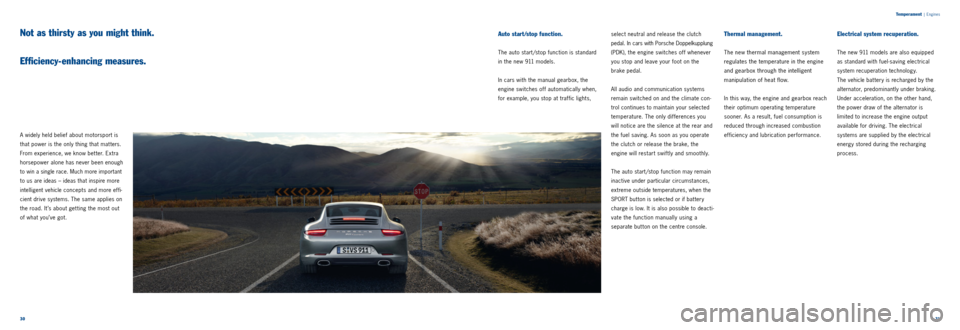
3031
A widely held belief about motorsport is
that power is the only thing that mat ters.
From experience, we know bet ter. Extra
horsepower alone has never been enough
to win a single race. Much more important
to us are ideas – ideas that inspire more
intelligent vehicle concepts and more ef fi-
cient drive systems. The same applies on
the road. It ’s about get ting the most out
of what you’ve got. select neutral and release the clutch
pedal. In cars with Porsche Doppel
kupplung
(PDK), the engine switches off whenever
you stop and leave your foot on the
brake pedal.
All audio and communication systems
remain switched on and the climate con -
trol continues to maintain your selected
temperature. The only differences you
will notice are the silence at the rear and
the fuel saving. As soon as you operate
the clutch or release the brake, the
engine will restart swiftly and smoothly.
The auto start/stop function may remain
inactive under particular circumstances,
extreme outside temperatures, when the
SPORT but ton is selected or if bat tery
charge is low. It is also possible to deacti -
vate the function manually using a
separate but ton on the centre console.
Thermal management.
The new thermal management system
regulates the temperature in the engine
and gearbox through the intelligent
manipulation of heat flow.
In this way, the engine and gearbox reach
their optimum operating temperature
sooner. As a result, fuel consumption is
reduced through increased combustion
efficiency and lubrication performance.
Electrical system recuperation.
The new 911 models are also equipped
as standard with fuel-saving electrical
system recuperation technology.
The vehicle bat tery is recharged by the
alternator, predominantly under braking.
Under acceleration, on the other hand,
the power draw of the alternator is
limited to increase the engine output
available for driving. The electrical
systems are supplied by the electrical
energy stored during the recharging
process.
Temperament | Engines
Auto start/stop function.
The auto start/stop function is standard
in the new 911 models.
In cars with the manual gearbox, the
engine switches off automatically when,
for example, you stop at traffic lights,
Not as thirsty as you might think.
Efficiency- enhancing measures.
Page 18 of 63
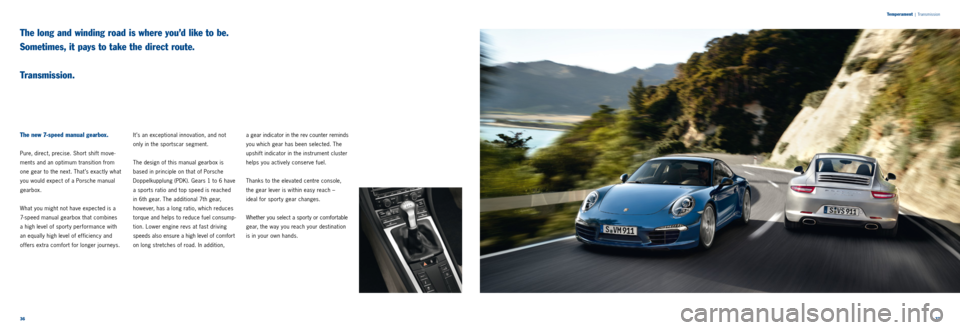
3637
Temperament
|
Transmission
The long and winding road is where you’d like to be.
Sometimes, it pays to take the direct route.
Transmission.
The new 7-speed manual gearbox.
Pure, direct, precise. Short shif t move -
ments and an optimum transition from
one gear to the next. That ’s exactly what
you would expect of a Porsche manual
gearbox.
What you might not have expected is a
7-speed manual gearbox that combines
a high level of sport y performance with
an equally high level of efficiency and
offers extra comfort for longer journeys. It’s an exceptional innovation, and not
only in the sportscar segment.
The design of this manual gearbox is
based in principle on that of Porsche
Doppelkupplung (PDK). Gears 1 to 6 have
a sports ratio and top speed is reached
in 6th gear. The additional 7th gear,
however, has a long ratio, which reduces
torque and helps to reduce fuel consump -
tion. Lower engine revs at fast driving
speeds also ensure a high level of com
fort
on long stretches of road. In addition
, a gear indicator in the rev counter reminds
you which gear has been selected. The
upshift indicator in the instrument cluster
helps you actively conserve fuel.
Thanks to the elevated centre console,
the gear lever is within easy reach –
ideal for sport y gear changes.
Whether you select a sporty or comfortable
gear, the way you reach your destination
is in your own hands.
Page 19 of 63

462135
7R
3839
Porsche Doppelkupplung (PDK).
Available as an option for the new 911
models is 7-speed PDK, featuring manual
and automatic modes. This double - clutch
transmission has been further refined and
enables extremely fast gear changes with
no interruption in the flow of power, which vastly improves acceleration at the
same time as reducing fuel consumption.
In total, PDK has seven gears at its disposal.
Gears 1 to 6 have a sports ratio and top
speed is reached in 6th gear. 7th gear has
a long ratio and helps to reduce fuel
consumption by keeping engine revs low.
Porsche Doppelkupplung (PDK)
PDK is essentially t wo gearboxes in one
and thus requires t wo clutches. This
double-clutch arrangement provides an
alternating, non-positive connection
bet ween the t wo half gearboxes and the
engine by means of t wo separate input
shafts.The flow of power from the engine is
transmit ted through one half gearbox and
one clutch at a time, while the next gear
is preselected in the second half gearbox.
During a gear change, therefore, one
clutch simply opens and the other closes
at the same time, enabling gear changes
to take place within milliseconds.
Temperament | Transmission
The effect is instant. Driving feels even
sportier and more dynamic, and agility
is increased. Depending on the gearshift
programme (SPORT button activated
or deactivated), the gear change is opti -
mised for comfort or for sport y driving.With the optional Sport Chrono Package,
PDK is enhanced by the ‘Launch Control’
and ‘motorsport- derived gearshif t strategy’
functions (p. 50). In this way, optimum use is made of the
vehicle’s momentum, allowing it to coast
for longer distances.
For example, you may want to slow down
from 100 km/ h (62 mph) to 80 km/ h
(49 mph) in anticipation of the change of
speed limit ahead. As soon as you release
the accelerator pedal, PDK deselects
the current gear automatically and you
begin to coast in neutral until you have
reached your desired speed. The moment
you engage the accelerator or brake
pedal, PDK selects the appropriate gear
smoothly and seamlessly within a fraction
of a second.
Another way to reduce fuel consumption is
to utilise the coasting function on downhill
gradients that are gentle enough for you
to maintain a constant speed. Efficient on
long journeys, such as on the motorway,
PDK remains ready to respond as swiftly
and precisely as you would expect.
In short, driving in coasting mode makes
a real impact on fuel consumption without
any need for compromise on comfort or
sporty performance.
Coasting.
The ‘coasting’ function available with
Porsche Doppelkupplung (PDK) enables
you to save even more fuel where the
situation allows. The engine is decoupled
from the transmission to prevent
deceleration caused by engine braking.
Page 54 of 63
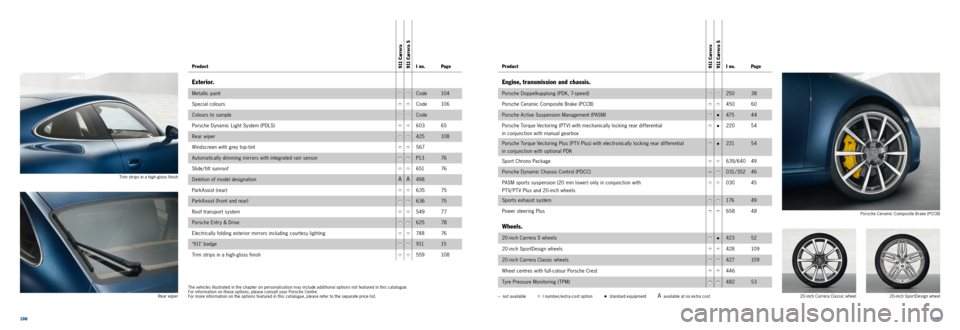
108109
– not available I number/extra - cost option• standard equipmentA available at no extra cost
Trim strips in a high-gloss finish
The vehicles illustrated in the chapter on personalisation may include additional options not featured in this catalogue.
For information on these options, please consult your Porsche Centre.
For more information on the options featured in this catalogue, please refer to the separate price list.
Rear wiper
20-inch Carrera Classic wheel20-inch SportDesign wheel
Product9 11 C a r r e r a
9 11 C a r r e r a SI no.Page
Exterior.
Metallic paint••Code10 4
Special colours
••Code 10 6
Colours to sample
••Code
Porsche Dynamic Light System (PDLS)
••603 65
Rear wiper
••425 10 8
W indscreen with grey top -tint
••567
Automatically dimming mirrors with integrated rain sensor
••P13 76
Slide/tilt sunroof
••651 76
Deletion of model designation
A A498
ParkAssist (rear)
••635 75
Park Assist (front and rear)
••636 75
Roof transport system
••549 77
Porsche Entry & Drive
••625 78
Electrically folding exterior mirrors including courtesy lighting
••74 8 76
‘911’ badge
••9 11 15
Trim strips in a high -gloss finish
••559 10 8
Product9 11 C a r r e r a
9 11 C a r r e r a SI no.Page
Engine, transmission and chassis.
Porsche Doppelkupplung (PDK, 7-speed)••25038
Porsche Ceramic Composite Brake (PCCB)
••450 60
Porsche Active Suspension Management (PASM)
• •475 44
Porsche Torque Vectoring (PTV) with mechanically locking rear differential
in conjunction with manual gearbox
• •220 54
Porsche Torque Vectoring Plus (PT V Plus) with electronically locking rear dif ferential
in conjunction with optional PDK
• •221 54
Sport Chrono Package
••639/640 49
Porsche Dynamic Chassis Control (PDCC)
–•031/ 352 46
PASM sports suspension (20 mm lower) only in conjunction with
PT V/ PT V Plus and 20 -inch wheels
••030 45
Sports exhaust system
••176 49
Power steering Plus
••658 48
Wheels.
20 -inch Carrera S wheels••423 52
20 - inch SportDesign wheels
••428 10 9
20 -inch Carrera Classic wheels
••427 10 9
Wheel centres with full - colour Porsche Crest
••446
Tyre Pressure Monitoring ( TPM)
••482 53
Porsche Ceramic Composite Brake (PCCB)
Page 60 of 63
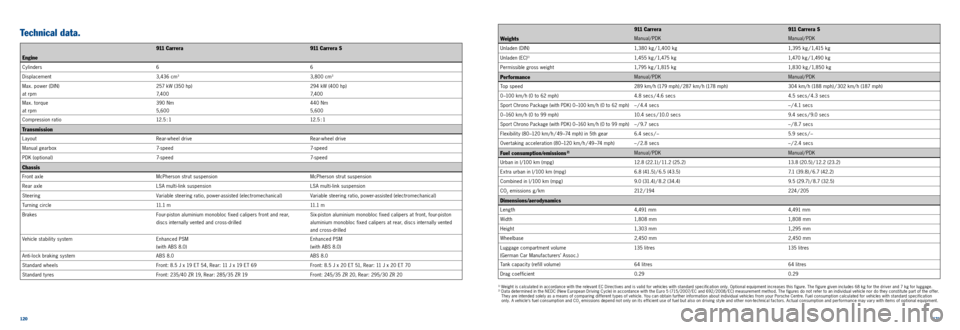
120121
9 11 C a r r e r a9 11 C a r r e r a S
Engine
C y linders 6 6
Displacement 3,436 cm
33,800 cm3
Max. power (DIN)
at rpm 257 kW (350 hp)
7, 4 0 0 294 kW (400 hp)
7, 4 0 0
Max. torque
at rpm 390 Nm
5,600 440 Nm
5,600
Compression ratio 12.5 : 1 12.5 : 1
Transmission
LayoutRear-wheel drive Rear-wheel drive
Manual gearbox 7-speed 7-speed
PDK (optional) 7-speed 7-speed
Chassis
Front axleMcPherson strut suspension McPherson strut suspension
Rear axle LSA multi-link suspension LSA multi-link suspension
Steering Variable steering ratio, power-assisted (electromechanical) Variable steering ratio, power-assisted (electromechanical)
Turning circle 11. 1 m 11. 1 m
Brakes Four-piston aluminium monobloc fixed calipers front and rear,
discs internally vented and cross-drilled Six-piston aluminium monobloc fixed calipers at front, four-piston
aluminium monobloc fixed calipers at rear, discs internally vented
and cross-drilled
Vehicle stabilit y system Enhanced PSM
(with ABS 8.0) Enhanced PSM
(with ABS 8.0)
Anti - lock braking system ABS 8.0 ABS 8.0
Standard wheels Front: 8.5 J x 19 ET 54, Rear: 11 J x 19 ET 69 Front: 8.5 J x 20 ET 51, Rear: 11 J x 20 ET 70
Standard tyres Front: 235/40 ZR 19, Rear: 285/35 ZR 19 Front: 245/35 ZR 20, Rear: 295/30 ZR 20
9 11 C a r r e r a9 11 C a r r e r a S
Weights
Manual/PDK Manual/PDK
Unladen (DIN) 1,380 kg / 1,400 kg 1,395 kg / 1,415 kg
Unladen (EC)
1)1,455 kg / 1,475 kg 1,470 kg / 1,490 kg
Pe r m issi b le gross we igh t 1,795 kg / 1,815 kg 1,830 kg / 1,850 kg
PerformanceManual/PDKManual/PDK
Top speed 289 km/ h (179 mph) / 287 km/ h (178 mph) 304 km/ h (188 mph) / 302 km/ h (187 mph)
0 –100 km/ h (0 to 62 mph) 4.8 secs / 4.6 secs 4.5 secs / 4.3 secs
Sport Chrono Package (with PDK) 0 –100 km/ h (0 to 62 mph)– / 4.4 secs – / 4.1 secs
0 –160 km/ h (0 to 99 mph) 10.4 secs / 10.0 secs 9.4 secs / 9.0 secs
Sport Chrono Package (with PDK) 0 –160 km/ h (0 to 99 mph)– / 9.7 secs – / 8.7 secs
Flexibilit y (80 –120 km/ h / 49 –74 mph) in 5th gear 6.4 secs / – 5.9 secs / –
Overtaking acceleration (80 –120 km/ h / 49 –74 mph) – / 2.8 secs – / 2.4 secs
Fuel consumption/emissions 2)Manual/PDKManual/PDK
Urban in l/100 km (mpg) 12.8 (22.1) / 11.2 (25.2) 13.8 (20.5) / 12.2 (23.2)
Extra urban in l/100 km (mpg) 6.8 (41.5) / 6.5 (43.5) 7.1 (39.8) / 6.7 (42.2)
Combined in l/100 km (mpg) 9.0 (31.4) / 8.2 (34.4) 9.5 (29.7) / 8.7 (32.5)
CO
2 emissions g/km 212 / 194 224 / 205
Dimensions/aerodynamics
Length4,491 m m 4,491 m m
Width 1,808 mm 1,808 mm
Height 1,303 mm 1, 2 9 5 m m
Wheelbase 2,450 mm 2,450 mm
Luggage compartment volume
(German Car Manufacturers’ Assoc.) 135 l i t res
135 l i t res
Tank capacity (refill volume) 64 litres 64 litres
Drag coef ficient 0.29 0.29
1) Weight is calculated in accordance with the relevant EC Directives and is valid for vehicles with standard specification only. Optional equipment increases this figure. The figure given includes 68 kg for the driver and 7 kg for luggage.2) Data determined in the NEDC (New European Driving Cycle) in accordance with the Euro 5 (715/2007/ EC and 692/2008/ EC) measurement method. The figures do not refer to an individual vehicle nor do they constitute part of the of fer.
They are intended solely as a means of comparing dif ferent t ypes of vehicle. You can obtain further information about individual vehicles from your Porsche Centre. Fuel consumption calculated for vehicles with standard specification
only. A vehicle‘s fuel consumption and CO
2 emissions depend not only on its ef ficient use of fuel but also on driving st yle and other non -technical factors. Actual consumption and per formance may var y with items of optional equipment.
Technical data.